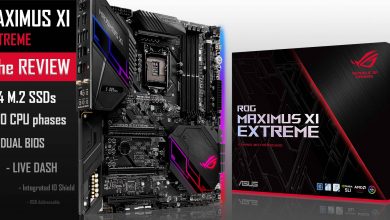Key Features
- Price: 290 USD (Confirmed)
- Release Date : 25th October 2021
- ATX Form Factor / 6 PCB Layers
- INTEL Z690 chipset
- LGA1700 CPU socket
- CPU Support
- Intel 12th Gen CORE CPU
- Intel 13th Gen CORE CPU
- 4 x 32GB 6,000 MHz DDR4, maximum 128 GB
- 3 x PCIe x16
- Back IO :
- HDMI 2.1
- DP 1.2 (through Type-C output)
- x4 USB 3.2 2nd gen. Type-A + TYPE-C RX/TX 10 Gbps
- x4 x USB 3.2 2nd gen. Type-A RX/TX 5 Gbps
- x2 USB 2.0 RX/TX 480 Mbps
- surge protected 2.5Gbps LAN controller
- WiFi 6E
- Realtek ALC 4080 Codec 7.1 channels audio,
- STORAGE
- 4 x M.2 SSD (PCIe 4.0)
- 6 x SATA 3 — RX/TX 6 Gbps
- x19 70 AMPS power stages
- PCIe 5.0 ready
- 6,000 MHz RAM clock
- Great Premium integrated AUDIO
- AWESOME cooling blocks
- VisionLINK feature
- Price
- Absence of Q-LED error screen or BIOS button
INSIDE THE BOX
- 4 SATA cables
- Q-Connector
- Dual band Antenna
- Manual
- DVD driver & Software
The Z690 AERO G is here to correct a lot of wrongs seen on the its predecessor, the Z590 VISION G. Especially in the VRM section which was unforgivingly hot and seemed to favor aesthetic over performance.
Good news is, Gigabyte has taken every critics shot at them last year, took the VISION, changed its name (wise choice) and gave us what might very well be the best mid-budget production motherboard on the market today.

Even though both boards are fundamentally different from its VISION predecessor, it does keep the over white theme.
We did notice a higher level of finish on all the cooling components, and a definite gain in robustness.

The components are easy to remove, even for novice users.

PCB

We are dealing with a 6 layered PCB ATX motherboard. Totally expected from a PCIe 4.0 enabled motherboard. Having more PCB layers (typically only 4) adds PCIe signal isolation which will allow a stable PCIe 4.0 and PCIe 5.0 support.
It also benefits VRM heat dissipation and audio quality. Obviously, a solid foundation for a performant and durable motherboard.
LGA 1700
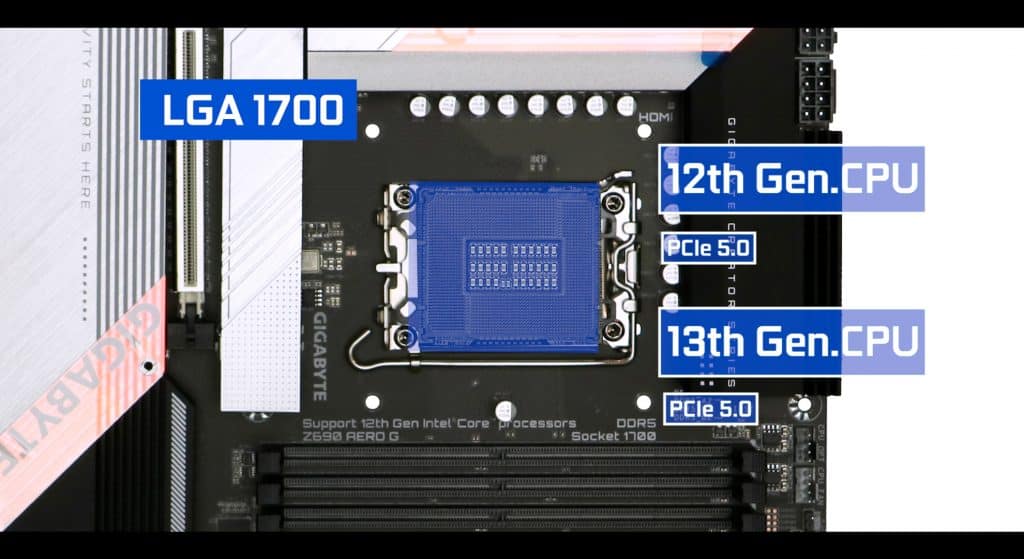
Our LGA1700 socket can support :
- 12 the Gen Intel CORE CPU
- 13 the Gen Intel CORE CPU
The LGA 1700 CPU socket features 500 more pins than its LGA1200 predecessor. This is a sizable jump made a necessity by:
- the new Alder Lake 10nm lithography, which allows more cores per CPU, and more transistors per core.
- the bandwidth increase brought by the PCIe 5.0 standard as well as the introduction of DDR5 RAM memory.

The PCIe 5.0 standard doubles its previous PCIe 4.0 bandwidth, going from 2 GB/s per PCIe lane, to 4 GB/s per PCIe lane.
This evolution brought in by Intel surprised the industry since there is no components, currently, which can use this new standard. Graphics Cards are still struggling to go beyond PCIe 3.0 level bandwidth and we do not have PCIe 5.0 enabled M.2 SSD. That last one being predominantly produced in PCIe 3.0 standard as well.
Therefore, the introduction of this new standard is more a marketing stunt than a selling argument. It does, however, make the Z690 line-up especially future proof since this standard should be around at least until 2025.
VRM
The Z690 AERO G shows-off a 40% power increase compared to its Z590 VISION G predecessor.

That’s a whooping 1,190 AMPS worth of juice to power our processor. Obviously more than you would ever need to power (and severely OC) any Intel processor of the Alder Lake line-up

VRM Cooling
This is where Gigabyte shows that it listened to its critics and took some definite action to address them.

Contrasting from the VISION small and insufficient VRM cooling components, the AERO G is now equipped with two large, thick and imposing VRM blocks.

Both of which are connected by a copper heat pipe to allow a faster and more homogenous heat transfer.

In addition, the VRM cooling block now features a double contact design offering both the motherboard chokes and power stages a direct thermal-padded contact, allowing a higher heat dissipation ratio.

Again another wrong corrected by Gigabyte.

It shows impressively wide walls which will help conducting more heat towards the radiating roof.
But I specially like the fact that the entire IO roof is in fact made of aluminum and provides an extended radiating solution to this muscled-up VRM!
Finally, I want to note the double-contact design introduced by ASUS on B550 powered motherboards.
A simple, inexpensive, but effective solution!
VRM TEMPS
Unlike its Z590 VISION G predecessor, the Z690 AERO G does wonder keeping its cooling blocks below 50c despite a durably overwhelmed VRM.

RAM
The Z690 AERO G (DDR5) can support up to 128 GB of DDR5 RAM, going upto 6 GHz.

Obviously a large jump when compared to its DDR4-only Z590 VISION predecessor, but not the fastest clock for DDR5 RAM. Reserve maybe motivated by a special care for the platform stability.

The Z690 AERO G comes in two flavors: a DDR4 or a DDR5 version. In our case. In our case, and since the AERO is here mainly to run production setups, I would highly suggest you purchased the more expensive DDR5 variant of the Z690 AERO G.
DDR5’s added memory bandwidth (50% higher than DDR4) and its higher clocks are particularly suited for graphic rendering and will directly impact your production yield.
M.2 SSD
Our board can support up-to 4 PCIe 4.0 M.2 SSDs, meaning that every M.2 SSD sticks can swap upto 64 Gbs worth of data individually.
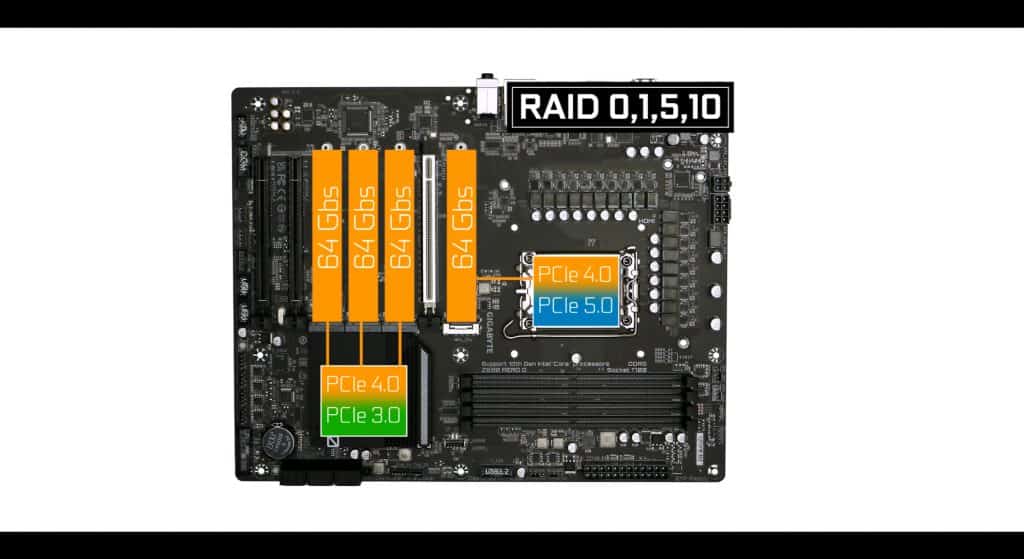
Central for content creators, especially knowing that our stick’s can be configured in RAID 0,1,5 or 10.
Obviously this will produce quite a bit of heat, and Gigabyte had the same thermal obsession it showed on this board VRM.
Both of our M.2 SSDs heat-shield are absolutely massive.
Obviously, more than enough to keep your PCIe 4.0 enable stick away from ever thermo-throttling.


Unsurprisingly, temps did absolutely great, keeping our M.2 SSD heat shield below 35c after 45 minutes of simultaneous drive stress test.

My only critic here, is the absence of screw-less mechanism as seen on Gigabyte’s main competitors, ASUS and MSI only to name a few.
Chipset
Intel’s long-awaited Z690 chipset is its first to natively support PCIe 4.0 standards. Of its 28 PCIe lanes, 12 of them are PCIe 4.0 which has for consequence an immediate bandwidth jump, not only for M.2 SSDs but also for the back-IO which shows dramatic bandwidth upgrades compared to its predecessor.

Maybe even more impressive, Intel succeeds where AMD failed, and shows a surprisingly low wattage for its Z690 chipset, allowing it to be cooled by a modest heat-sink. Something which will positively impact manufacturing cost, and hence, your wallet.
In contrast AMD’s X570 chipset features a boiling 11 watts forcing most of its motherboards to be cooled with a fan, adding moving parts, noise as well as a significant cost bump.

As a consequence, a much lighter and smaller heatshield is now enough to cool the small 6 watts of the Z690 chipsets.
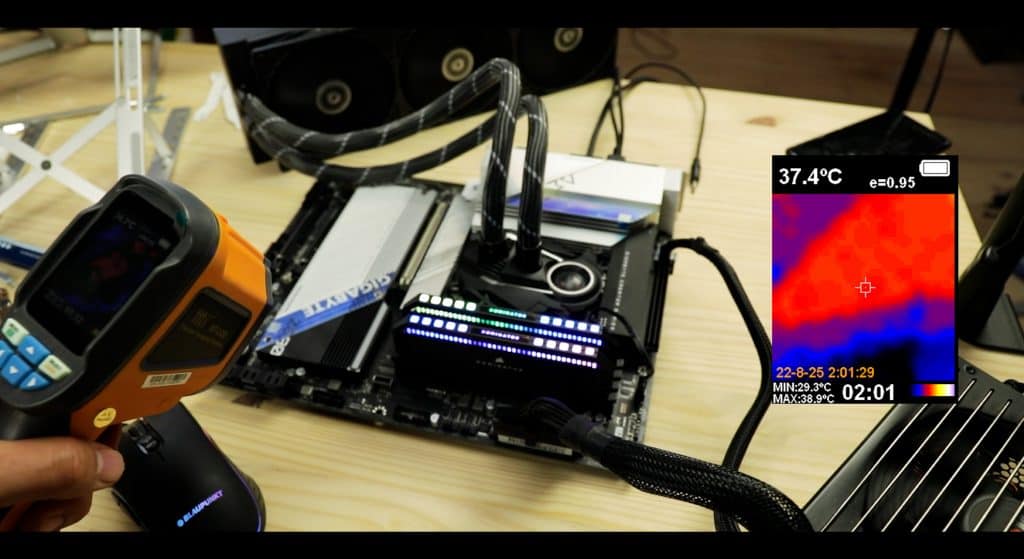
Temps are equally impressive, staying below 40c during a 60 minute chipset linked stress test.
SATA 3.0
For a more classical storage solutions, we have our usual SATA 3.0 plugs. 6 in total, with a transfer rate of 6 Gbps each. They can be configured to run into a 0,1, 5 or 10 RAID configuration.

PCIe Slots
The Gigabyte Z690 AERO G has 3 PCIe expansion slots.:
- 3 16 lanes with different speeds
Only the closest one to your CPU can deliver up to 16 Lanes worth of bandwidth meaning, this is where you’d want your video card to be placed for optimal performances.
It can output PCIe 5.0 bandwidth at 4 GB/s per lane, for an impressive total of 64 GB/s.
Our remaining two naked 16 slots are capped at 4 PCIe lanes (PCIe 3.0 standard) which is not exactly GPU friendly.
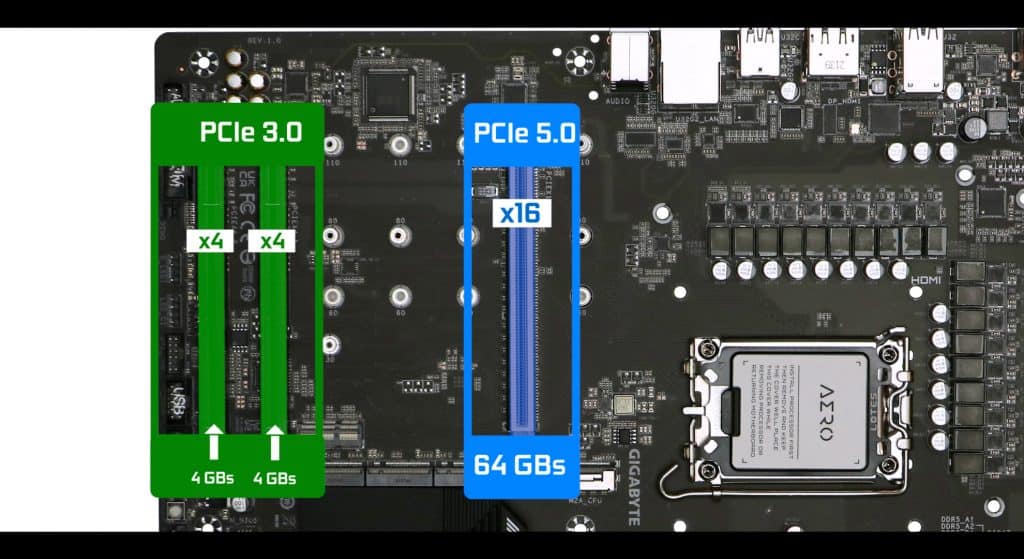
Worth noting that, with the current bandwidth outputs of AMD or Nvidia graphics cards, there are no performance gains between PCIe 3 or PCIe 4 or even PCIe 5 standards.
It is great for future proofing (and marketing), but that’s about it .
In short, a single GPU motherboard, which always seems to be a surprise when talking about a production / content creator focus motherboard,
The fact is that current video cards have so much computing power to give, it is less and less common for a production setup to necessitate a second one.
In addition, the GPU scarcity of the past few years have pushed motherboard manufacturers to ditch multiple GPU support in general.
Not necessary a bad thing.
Back IO

First let me note the presence of an IO integrated plate which is always a good point!
- x2 USB 2.0 (480 Mbs)
- WiFi 6 Dual Band AX201 adaptor (2.4 Gbps) / BT 5.2
- x4 USB 3.2 1st Gen (5 Gbs)
- 2.1 HDMI (4k@60fps)
- Display Port (IN) for VisionLink feature
- x4 USB 3.2 2nd GEN USB (10 Gbps) including a TYPE-C.
- x1 surge protected Intel I225-V 2.5Gbps LAN controller (step 3)
- ALC 4080 REALTEK audio codec, which is about the best integrated AUDIO Codec a board can have. It takes full advantage of the numerous PCB layers available to it, since both left and right audio channels have been traced on individual PCB layers, further improving its signal isolation and protecting it from static interferences.
Great for playing and recording alike.

Front Panel Connectors

USB 3.2

Gigabyte Z690 AERO G Front Panel Connector 
We have :
- x2 2nd gen USB front panel connectors , good for our AIO pumps, or PSU monitoring,
- x2 5 Gbs USB 3.2 (1st Gen) front panel Connector
- x1 10 Gbs USB 3.2 (2nd Gen) TYPE-C front panel Connector
- x1 40 Gbs Thunderbolt 4.0
Overall a well furnished board-based peripherals in par with its purpose (production) and pricing.
Cooling connectors
We have 8 hybrid FAN connectors, which is great news.
Every single connector can support individually either a PWM fan, a water pump or even a flow sensor, giving this board agility and the ability to support the most complex cooling solutions possible
Definitely what you want to see on an enthusiast driven board.
EZ Debugger
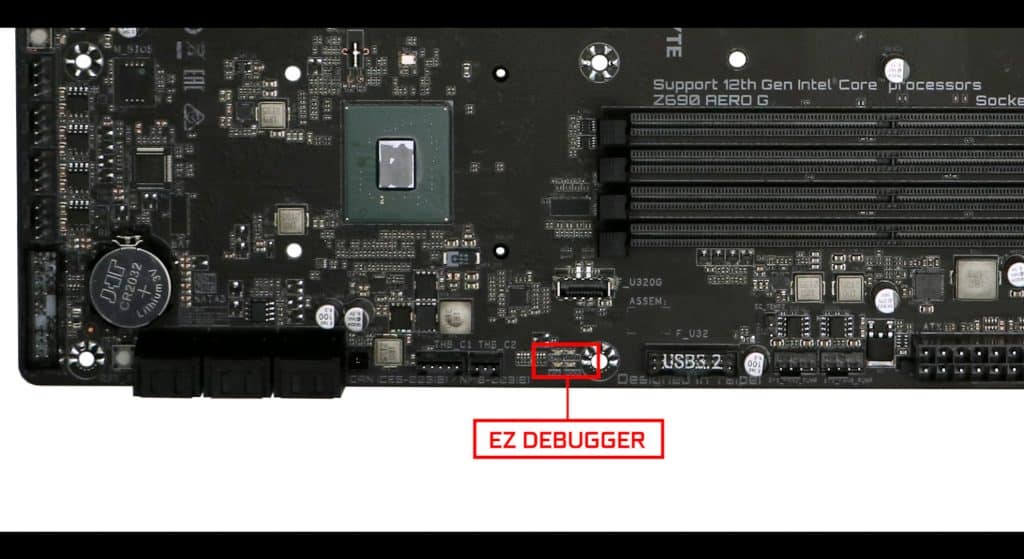
The EZ debugger is really the a must-have on PCIe 4.0 / PCIe 5.0 enabled boards. More often than not, enthusiasts can’t resist the call to find their RAM or CPU overclocking limits, and fail boots becomes a daily incidence.
We also have a soldered reset bouton as well as a flash_BIOS button, always great for a CPU-less flash update..
I do regret not seeing a Q-Code screen which would have refined our troubleshooting experience with greater precision. Especially when seeing that the budget of this board should amply suffice to add such an important feature.
AURA Sync Effect
Gigabyte decided to keep the AERO G on sober in terms of RGB. No back lights or PCB embedded RGB. Which I tend to like. When prioritizing stability, removing all the none-essentials is always a good idea.
But in case you would lose sleep over it, you still have a bunch of connectors for your RGB exports:

- 2 classic RGB Connectors
- 2 Addressable RGB Connectors
All of the above are obviously fully customizable (and sync-able) through Gigabyte proprietary “FUSION” software.
I have to give it to Gigabyte, it is slick looking, in tune with the overall white spirit of the VISION/AERO branding but most importantly, it is rock stable! Very important on a board which builds its repute on being durable.

Menu is easy to navigate and self-explanatory. The Overclocking is easy and automated, so it ll get the most of your CPU without an insane over voltage.
Had some issue decrypting the font, which I find a bit hieroglyphic, but other than that… an absolute breath to use!

CONCLUSION
At around 260-300 USD before taxes, the Z690 AERO G (DDR5) has a 50 bucks premium over its Z590 powered predecessor which is no little difference. And the question remains, is it worth it?
I’m going to start with the good points:
It takes back all the great feature we saw on its predecessor, the Z590 VISION G, and that’s great. But most importantly Gigabyte seems to have listen to last year’s critics, especially on the VRM topic, and corrected every single issue reported. And despite having a drastically more powerful VRM, temps are improved and are absolutely exemplary.
In fact, they should be regarded as a gold standard by the competition, nothing less.
In addition, the Z690 AERO G adds both the PCIe 5.0 standard and DDR5 RAM memory which obviously will be central for a greater production yield.
On the down side, I do find the troubleshooting solution quiet limited, which given the amount of power and bandwidth coursing through the vain of this thing, might be problematic in case of failed boot. But now I am being picky.
Truth is , if you are a content creator, or production focused used, well at that price point, no brands or models will bring you this level of computing and agility. It’s not the most fun motherboard you can get, god no, but if you are in for a production build, there is nowhere else your money wants to be.



